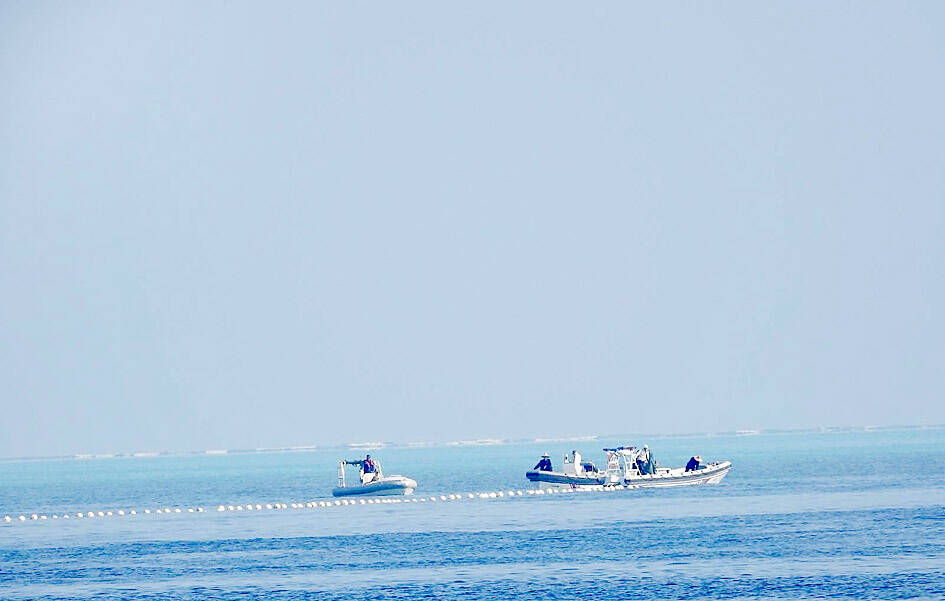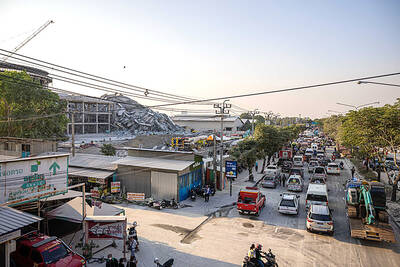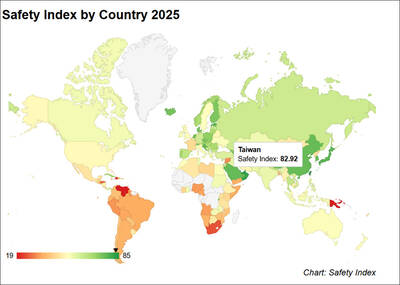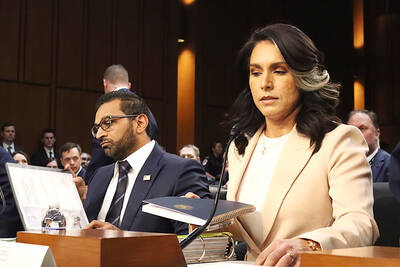Beijing yesterday warned Manila not to “stir up trouble” after the Philippine Coast Guard said it removed a floating barrier at a disputed reef that was allegedly deployed by China to block Filipino fishers from the area.
Scarborough Shoal (Huangyan Island, 黃岩島) in the South China Sea has long been a source of tension between the nations. China seized the ring of reefs from the Philippines in 2012 and has since deployed patrol boats.
The latest spat was sparked by a 300m floating barrier that was found across the entrance of the shoal last week during a routine Philippine government resupply mission to fishers plying the waters near the shoal.

Photo: EPA-EFE
The Philippines condemned the installation and its coast guard announced on Monday that it had “successfully” removed the barrier from the reef, which Manila calls Bajo de Masinloc, in a special operation ordered by Philippine President Ferdinand Marcos Jr.
The Philippine Coast Guard yesterday said that it had cut a rope tethering the buoys to an anchor on the seabed, and hauled away the anchor, which allowed the line to drift.
Chinese Ministry of Foreign Affairs spokesman Wang Wenbin (汪文斌) hit back yesterday, saying that Beijing “firmly upholds the sovereignty and maritime rights and interests of the Huangyan Island.”
“We advise the Philippines not to provoke or stir up trouble,” Wang said.
Philippine National Security Adviser Eduardo Ano said his nation was “well within its rights” to remove any barrier at the reef.
China claims sovereignty over almost the entire South China Sea, despite a 2016 international court ruling that its stance has no legal basis.
The shoal, which Taiwan also claims, is 240km west of the Philippines’ main island of Luzon and nearly 900km from the nearest major Chinese land mass of Hainan.
Under the 1982 UN Convention on the Law of the Sea, which China helped negotiate, nations have jurisdiction over the natural resources within about 200 nautical miles (370km) of their shore.
The Philippine Coast Guard on Monday released a video showing a man wearing snorkeling gear using a knife to sever a rope attached to white buoys, while another showed an anchor being hauled from the water into a wooden outrigger boat.
After the rope was cut, the Chinese government removed the barrier, Jay Tarriela, Philippine Coast Guard spokesman for the West Philippine Sea, told reporters yesterday.
The floating barrier had prevented fishing boats from entering the shoal’s shallow waters, where fish are more abundant.
Philippine officials previously accused the Chinese Coast Guard of installing the barrier before a Philippine Bureau of Fisheries and Aquatic Resources resupply ship arrived at the shoal on Wednesday last week.
The Philippine Ministry of Foreign Affairs on Monday said that it would “take all appropriate measures to protect our country’s sovereignty and the livelihood of our fisherfolk,” without elaborating.

AIR SUPPORT: The Ministry of National Defense thanked the US for the delivery, adding that it was an indicator of the White House’s commitment to the Taiwan Relations Act Deputy Minister of National Defense Po Horng-huei (柏鴻輝) and Representative to the US Alexander Yui on Friday attended a delivery ceremony for the first of Taiwan’s long-awaited 66 F-16C/D Block 70 jets at a Lockheed Martin Corp factory in Greenville, South Carolina. “We are so proud to be the global home of the F-16 and to support Taiwan’s air defense capabilities,” US Representative William Timmons wrote on X, alongside a photograph of Taiwanese and US officials at the event. The F-16C/D Block 70 jets Taiwan ordered have the same capabilities as aircraft that had been upgraded to F-16Vs. The batch of Lockheed Martin

GRIDLOCK: The National Fire Agency’s Special Search and Rescue team is on standby to travel to the countries to help out with the rescue effort A powerful earthquake rocked Myanmar and neighboring Thailand yesterday, killing at least three people in Bangkok and burying dozens when a high-rise building under construction collapsed. Footage shared on social media from Myanmar’s second-largest city showed widespread destruction, raising fears that many were trapped under the rubble or killed. The magnitude 7.7 earthquake, with an epicenter near Mandalay in Myanmar, struck at midday and was followed by a strong magnitude 6.4 aftershock. The extent of death, injury and destruction — especially in Myanmar, which is embroiled in a civil war and where information is tightly controlled at the best of times —

Taiwan was ranked the fourth-safest country in the world with a score of 82.9, trailing only Andorra, the United Arab Emirates and Qatar in Numbeo’s Safety Index by Country report. Taiwan’s score improved by 0.1 points compared with last year’s mid-year report, which had Taiwan fourth with a score of 82.8. However, both scores were lower than in last year’s first review, when Taiwan scored 83.3, and are a long way from when Taiwan was named the second-safest country in the world in 2021, scoring 84.8. Taiwan ranked higher than Singapore in ninth with a score of 77.4 and Japan in 10th with

SECURITY RISK: If there is a conflict between China and Taiwan, ‘there would likely be significant consequences to global economic and security interests,’ it said China remains the top military and cyber threat to the US and continues to make progress on capabilities to seize Taiwan, a report by US intelligence agencies said on Tuesday. The report provides an overview of the “collective insights” of top US intelligence agencies about the security threats to the US posed by foreign nations and criminal organizations. In its Annual Threat Assessment, the agencies divided threats facing the US into two broad categories, “nonstate transnational criminals and terrorists” and “major state actors,” with China, Russia, Iran and North Korea named. Of those countries, “China presents the most comprehensive and robust military threat